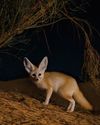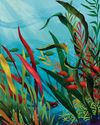Asymmetry: why it exists in animals
BBC Wildlife
|July 2022
All but the simplest animals have a body with two distinct sides – one left and one right – that are roughly mirror images, at least in the embryo.

That ‘bilateral symmetry’ can even be seen in starfish before the larvae develop into adults with multiple arms radiating from the centre (‘radial symmetry’). But while left and right may look similar, the bodies of most creatures are only superficially symmetrical.
How are animals asymmetric?
Asymmetry can appear across the whole body. One example is flatfish: a juvenile starry flounder swims vertically and has eyes on opposite sides of its head, but one eye will migrate across its skull as it matures so both eyes end up on either the left or right of a lopsided adult. The male fiddler crab, meanwhile, has one major claw – used to fight rivals and impress females – that can reach half the animal’s total size.
Each body part can have asymmetry too. Parts can exist in mirror-image forms that can’t be superimposed on one another – like our right and left hands, for example. Known as ‘chiral’ structures, they can take either right-handed (dextral) or left-handed (sinistral) forms.
What determines the direction of the asymmetry?
Bu hikaye BBC Wildlife dergisinin July 2022 baskısından alınmıştır.
Binlerce özenle seçilmiş premium hikayeye ve 9.000'den fazla dergi ve gazeteye erişmek için Magzter GOLD'a abone olun.
Zaten abone misiniz? Oturum aç
BBC Wildlife'den DAHA FAZLA HİKAYE

BBC Wildlife
"I was terrified the elephant would ram us"
African elephant in Kenya
2 mins
January 2026

BBC Wildlife
ALL YOU EVER NEEDED TO KNOW ABOUT THE Fennec fox
THE FENNEC FOX IS THE SMALLEST fox in the world, with a body length that can be as little as 24cm.
3 mins
January 2026

BBC Wildlife
INTO THE PLASTISPHERE
A unique synthetic ecosystem is evolving in our oceans – welcome to the plastisphere
7 mins
January 2026

BBC Wildlife
“More than half of all animal life exists in a parasitic relationship, and all life lives in symbiosis”
Our survival depends on species evolving to live together - but some relationships take dark turns
7 mins
January 2026

BBC Wildlife
Are animals able to dream?
SLEEP IS A MYSTERIOUS THING. FOR A long time, we weren't sure why we do it.
1 mins
January 2026

BBC Wildlife
Does a cuckoo know it's a cuckoo?
ABSURD LITTLE BIRDS ACROSS THE world lay their eggs in the nests of other species, leaving the hapless parents to raise a changeling at the expense of their own offspring.
2 mins
January 2026

BBC Wildlife
Orcas killing young sharks
Juvenile great whites are easy prey for orca pod
1 mins
January 2026

BBC Wildlife
Ocean goes on tour
Acclaimed film touring the UK, backed by live orchestra and choir
1 min
January 2026

BBC Wildlife
Feisty bats hunt like lions
Winged mammals use a 'hang and wait' strategy to take down large prey
1 mins
January 2026

BBC Wildlife
SNAP-CHAT
Richard Birchett on magical merlins, wily coyotes and charging deer
2 mins
January 2026
Translate
Change font size

